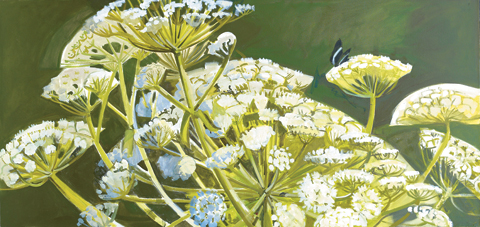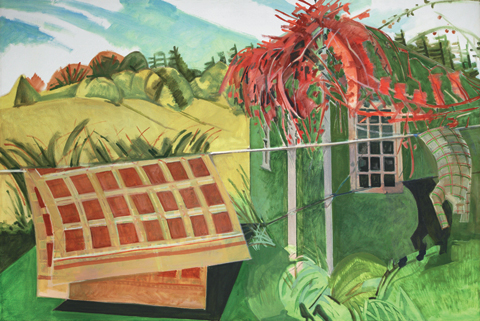
‘COW PARSNIP, 1996’ |
"Lois Dodd: Catching the Light" is the kind of show that reminds you why you got interested in art in the first place. The paintings are terrific and the big, first-floor gallery at the Portland Museum of Art has never looked better.
This is Dodd's first career retrospective, and it is long overdue. There are more than 50 paintings that span 60 years. Many are large, the quality is uniformly high, and her method, while it has evolved over the years, has remained steady and consistent. Early in her career she found a way to work that suited her own needs and fulfilled her understanding of what art was about, and has followed it ever since with remarkable focus and clarity.
I've been a fan of Dodd's for many years, and I'm in good company. She's had a regular and appreciative audience of critics and other artists who love her work and sometimes learn from her way of seeing, or from her decades-long faith in her relationship to her own vision, or from both. It would be no surprise to see a steady stream of visitors from New York and farther coming to Portland for this show.
Dodd began her showing career in the early 1950s, right around the high-water mark of New York School abstraction. At the time, modernist ideas had coalesced into something of an imperative toward abstraction, but there were a number of artists who felt that the sense of place and implicit narrative of representation still had powerful valence.
There was no going back after the reiterative self-awareness of Cézanne, Malevich, Eliot, Joyce, and Mondrian established conclusively that art was about the relationship between artist and viewer, and not about the subject. But a number of artists felt there was power in the relationship of the artist not so much to the subject, but to the subjective nature of the moment in its presence, and to the act of seeing it. Every day, even in the same spot, is different. Among those artists were Fairfield Porter, Alex Katz, Neil Welliver, and, especially, Lois Dodd. Many of them came to Maine from New York for part of the year, and in, say, the 1970s, one could easily walk into a 57th Street gallery and spot a recognizable scene from Lincolnville.
But it wasn't about the scene as subject as much as it was about the artist's presence at a place as an event. Dodd picks out subjects that will make a painting that resonates with her own interests. The rest is up to the viewer, who will take away their own, possibly rather different, experience, not of the place but of the painting.

‘RED VINE AND BLANKET, 1979’ |
Process is of very little value when discerning an artist's thinking, but method is useful. The famous William Carlos Williams dictum "No ideas but in things" is at work here. In this show we can take a few of the formal outliers as a entry point for apprehending the pervasive, and interesting, underlying thinking that informs Dodd's whole body of work.